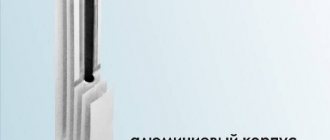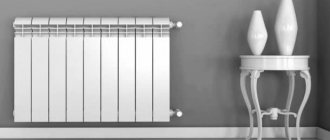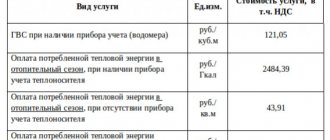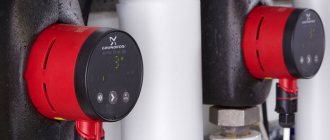The key task of any radiator is to effectively heat the room. For this reason, one of the main parameters that you need to focus on when choosing is the power (heat transfer) of a bimetallic radiator .
For each device model, the value is different, since it is determined depending on the volume (capacity) of the sections and their number. Knowing the power of 1 section of a bimetallic radiator, you can correctly calculate the optimal dimensions of the device for a specific room.
What is heat transfer?
Heat flow, power and heat transfer of bimetallic radiators are different designations for the same parameter, which determines the amount of heat generated by the device over a certain period of time. The parameter changes in Watts. Sometimes it is expressed in calories per hour. Converting the value to the desired unit is simple: 1 Watt = 859.8 cal/hour.
The heat coming from the bimetallic radiator warms the room as a result of three processes:
- Heat transfer.
- Convection.
- Radiation.
All bimetallic devices “use” all three types of heating, but the proportions may be different. In the standard case, at least 25% of the thermal energy is transferred from the device to the surrounding space through radiation.
How are section capacity and power related?
The power of bimetallic radiators is directly related to the size and capacity of the device. The less media in the battery, the more economical and efficient the device is . This is due to the fact that a smaller amount of working medium heats up much faster and less resources are spent on this. The section capacity depends on the center distance:
- 200 mm - the volume of coolant is from 0.1 to 0.16 liters.
- 350 mm - from 0.17 to 0.2 liters.
- 500 mm - from 0.2 to 0.3 liters.
Having data on the capacity and power of one section of a bimetallic radiator, you can calculate how much coolant is required to heat a particular room. For example: if the design of the device includes 10 sections with a center distance of 500 mm, then they will hold a total of 2 to 3 liters of water, and a radiator of 9 sections with a center distance of 350 mm holds about 1.6 liters of coolant.
At the same time, the strength of the heat flow of a 9-section bimetallic radiator with an interaxial distance of 350 mm allows you to effectively heat a room of 14 square meters. m.
A simple way to calculate when replacing old batteries
If you decide to replace an old cast iron radiator, then you can use a simple method and calculate the required number of battery sections. To do this, you need to take into account some factors
. Namely:
- The heat transfer of bimetallic and cast iron radiators is slightly different. If for the first this value is 200 W per section, then for the second it is 180 W.
- how the old battery warmed up. If her work suits you, then that's good. If not, then you can increase the number of sections.
- After a certain time, the heating radiator will become a little worse. This is due to clogging of the internal cavities of the device.
As a rule, when replacing a cast-iron heating radiator with a bimetallic one, the number of battery sections does not change. Of course, if the performance of the old battery suited you. If there was not enough heat, then you can increase the number of sections.
What to do if the radiator power was selected incorrectly?
If an error occurred when determining the optimal power of bimetallic radiators and an insufficiently efficient device was purchased, the situation can be corrected: many devices are sold section by section, that is, if necessary, you can increase the number of sections . This makes it possible to “assemble” a radiator of optimal size and power for a specific room.
If there are no doubts about the accuracy of the calculation, you can make a choice in favor of a one-piece model: devices are produced whose design includes up to 14 sections or more.
Standard power value for sections with center distances of 500 and 350 mm
The heat transfer value of bimetallic radiators is indicated in the technical data sheet for the product. Before purchasing, it is advisable to read the documentation for the device, since this parameter is individual for each model. If there is no data in the data sheet, you can use the average power value of 1 section of a bimetallic radiator:
- Devices with a center distance of 500 mm are standard and the most popular. Traditionally installed in apartments. The average heat transfer value of one section of a bimetallic radiator ranges from 170 to 210 W. It is important to consider that the stated indicators are usually slightly higher than the real ones, since measurements are carried out under ideal conditions. Therefore, it is more correct to focus on the minimum power of one section of a bimetallic radiator of 150 W. The working pressure of one section is 20 bar, the pressure test is 30 bar, the average weight is about 1.92 kg.
- Devices with a center distance of 350 mm usually mounted next to large windows or in hard-to-reach places . According to the technical data sheet, the standard power value of 1 section of a bimetallic radiator is from 120 to 150 W. The real value is slightly lower - 100-120 W. The working pressure of each section is 20 bar, the pressure test is 30 bar, the average weight is about 1.36 kg.
Expert advice: when determining the optimal power of a bimetallic radiator, it is advisable to leave a small “reserve”, otherwise it may be necessary to expand the device - install additional sections.
Why do you need a heating element?
TEN for radiators ensures uninterrupted operation of the heating system, even if it is not possible to use the usual heating method. Essentially, a heating element is a metal tube with a spiral sealed inside it. These elements are isolated from each other using a special filler. The heating element is connected to the pipeline system as additional equipment. In addition, a heating element inserted into an old cast-iron battery can easily heat a small garage, greenhouse or other outbuilding. And there are quite a lot of such examples, if you believe the statements of our skilled men on various thematic forums.
Installing heating elements for batteries allows you to take advantage of all the advantages of electric heating - ease of operation, reliability and high efficiency. But unlike electric heaters, these devices are installed directly into the system, therefore they are completely invisible and do not take up additional space. Thanks to the temperature control function, the heating element is able to maintain the set temperature.
Rules for determining the optimal power of a bimetallic radiator
To determine the optimal power and heat transfer of a metal radiator for a specific room, you should:
- Study in detail the technical data sheet for the device , which indicates the power of one section of the bimetallic radiator.
- Accurately determine the area of the heated room , and not the whole house, but a specific room.
- Use the formula for calculating the power and heat transfer of a bimetallic radiator , according to which 100 W of thermal power is required per 1 square meter of a room in which the ceiling height is 2.7 meters. It should be borne in mind that this method of calculation is standard and unified, that is, it does not take into account the individual characteristics of the room. When performing calculations for rooms located on the top floor of a building, having two “external” walls (that is, corner ones), with higher or lower ceiling heights, and in some other cases, additional correction factors are introduced. Therefore, the calculation formula should be selected taking into account the characteristics of a particular room.
Do you want to know the power of one section of a bimetallic radiator of a specific model? Do you find it difficult to determine the optimal parameters of your heating device? Contact a SANTEKHPROM representative by phone. Our specialist will answer in detail any questions regarding the heat transfer of bimetallic radiators.
Features of different heating convectors
You should understand the differences between different types of batteries made of two metals. Composite products are usually classified according to the following criteria: composition of the internal rod, external design and type of metal used.
Bimetallic and semi-bimetallic radiators
Users often confuse true bimetallic batteries with “half-breeds” - semi-bimetallic counterparts.
"Pure" bimetal
Aluminum is used to make the outer casing of the device. The convector core is 100% stainless steel or copper. During the production process, pipes placed in special molds are filled under pressure with aluminum - a sealed structure is formed.
The outer shell is not in contact with the coolant and acts as a heat exchanger. The main feature of bimetallic radiators is their high strength and guarantee against leaks
A high-grade bimetal withstands the pressure of centralized and autonomous heating systems.
Semi-bimetallic batteries
The internal “skeleton” of the radiator is made of two metals: vertical guides – stainless steel, horizontal pipeline – aluminum. The reverse combination is also possible.
Such an alliance of metals is not able to ensure adequate reliability of central heating communications. The coolant may contain alkali, which, when interacting with aluminum, provokes corrosion. Over time, destructive processes “transition” to the steel components of the radiator.
In addition, the integrity of the product may be at risk due to thermal expansion of metals - leaks are possible at boundary temperatures.
Externally, semi-bimetallic radiators do not differ from their full-fledged bimetallic counterparts. "Half-breed" gives lighter weight and lower cost
It is better to avoid purchasing low-quality composites, especially when it comes to centralized heating.
Sectional and monolithic models
Among the variety of bimetallic heating batteries, there are two types of designs:
- sectional:
- monolithic.
Models assembled from sections are attractive due to their variability of characteristics. They provide the opportunity to purchase a device with the exact heat transfer values required for heating rooms. Monolithic ones do not have such advantages.
Typesetting systems
Collapsible radiators, the panels of which are connected using nipples. Horizontal sections of pipes of individual sections have multi-directional threads for joining the fastening nipples and the sealing strip.
Stacked models are more popular due to their practicality - it is possible to regulate the thermal power by adding or subtracting the required number of sections. An additional advantage is maintainability.
Disadvantages of sectional radiators:
- joints are weak points of collectors where leaks are likely;
- limited operating pressure – up to 20-30 bar.
Significant disadvantages also include partial ingress of coolant onto the aluminum “jacket” during leakage.
Monolithic devices
One-piece modifications do not have the listed disadvantages. The cast radiator is capable of withstanding pressure surges within 100 atmospheres.
Disadvantages of monolithic batteries: there is no possibility to vary the thermal power, inflated cost - 20-30% more expensive than sectional models with similar parameters
For high-rise buildings (10 or more floors), experts recommend choosing solid radiators, since there will be significant pressure in the heating system.
Copper or steel core?
Most manufacturers offer hybrid batteries with a steel tube frame. The main reason is the affordability of the metal and good strength characteristics. The symbiosis of steel and aluminum made it possible to achieve resistance to pressure fluctuations in the heating system, increase the level of heat transfer of the convector and reduce its inertness.
In copper + aluminum radiators, the heat exchange tubes are made of copper. Heating panels - aluminum plates soldered to an internal copper frame
Advantages of copper core batteries:
- there is no likelihood of corrosion;
- a copper pipeline withstands any water hammer - the best option for use in domestic centralized heating systems;
- high efficiency of the device - the heat transfer of copper exceeds that of steel.
Copper-aluminum radiators have a service life of more than 50 years. The disadvantage of copper modifications is the high price.










